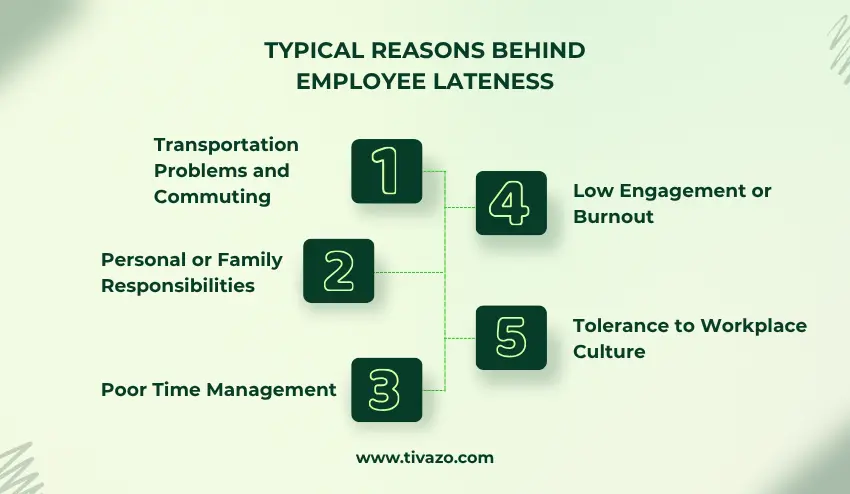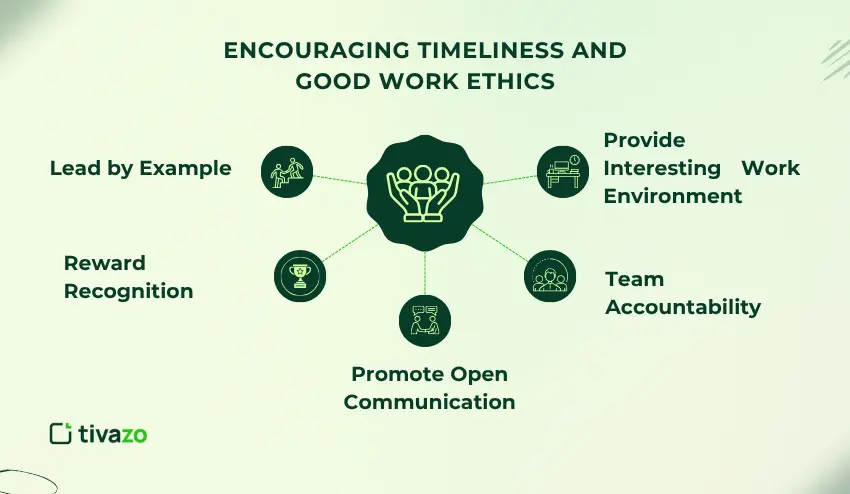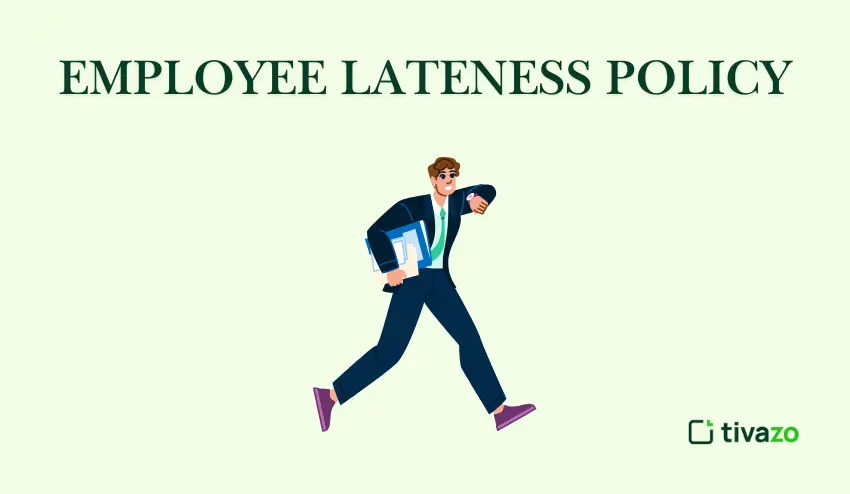It is something that every organization has to deal with, employees reporting late, meetings late and workdays late. Although the lateness might not appear that bad sometimes, recurring delays can be detrimental to productivity, morale and cause friction amongst the members of the team. It is where an employee lateness policy would come in handy.
An effective lateness policy is not only about discipline, but it is also about equity, responsibility, and respect of time of all people. It assists managers to deal with lateness on a regular basis and provide employees with a clear picture of what is expected.
In this blog we shall discuss what is an employee lateness policy, why it is important and how to develop an effective yet employee-friendly one. You will also get the practical tips on how to measure lateness, deal with chronic offenders and encourage punctuality without ruining the team trust.
What Is Employee Lateness Policy?
Being late is not a personal issue only, but it can have an impact on the whole team and the business performance in general. In the absence of an official employee lateness policy, the managers might not be able to ensure that employees are always punctual, and this will result in frustration, resentment, and reduced productivity.

This is why it is necessary to have a clear policy:
- Retains Productivity: The tardiness of arrivals may postpone the projects, decrease the efficiency of the working process and affect the deadline of the clients. One of the policies would make sure that we all know how to be on time.
- Ensures Fairness: Fair enforcement eliminates the feeling of favoritism or biasness. When employees observe that rules are applied equally, chances are that they will respect them.
- Safeguards Group Spirit: Constant lateness by select team members may cause frustration among the time conscious members. A policy conveys the message that time is precious to each.
- Lessens Managerial Pressure: There is no need to make ad-hoc decisions on lateness by the managers, which saves time and conflicts.
- Favors Legal Conformance: An official policy is capable of defending the organization during a dispute over attendance or disciplinary measures.
Scenario: A small marketing company realized that people were missing their deadlines and customers were getting frustrated because of irregular starting times. As soon as they introduced a formal policy on lateness, the level of punctuality improved 40 percent in two months, and the level of team satisfaction rose.
Typical Reasons behind Employee Lateness
Knowing the reasons behind employees coming late would assist the managers in mitigating the underlying factors rather than simply implementing the rules. Identifying patterns would enable a more balanced implementation of an employee lateness policy.

- Transportation Problems and Commuting.
Traffic, delays in public transport or lengthy commutes may be a contributing factor to chronic lateness. These problems can be mitigated by offering flexible working hours or telecommuting. - Personal or Family Responsibilities.
Lateness may sometimes be occasioned by childcare, eldercare or personal emergencies. There should be reporting policies on such cases. - Poor Time Management
Other workers have difficulties in planning or prioritizing their morning schedules. Punctuality can be enhanced by conducting training on time management and sending reminders. - Low Engagement or Burnout
Unmotivated or disconnected employees can come late to work due to lack of motivation. It is important to identify and deal with burnout or lack of engagement. - Tolerance to Workplace Culture.
In case an organization has a history of condoning lateness, employees might not feel responsible. The only way to alter this culture is through consistent implementation of the employee lateness policy.
This way, the employee lateness policy becomes more effective, and just as the managers can customize their approach by determining the underlying causes.
7 Strategies to Create an Effective Employee Lateness Policy
Developing an effective lateness policy is not just a matter of rules but rather it is an issue of accountability and the need to be fair and trusting. The following is a closer examination of seven viable action plans to make your policy work:
1. Set Clear Definitions of Lateness
- Indicate precisely what will be considered late, e.g. 5 minutes after the scheduled time.
- Establish various stages of lateness (minor and chronic) to inform the right response.
- Use specific words such as frequent tardiness and this may cause confusion or arguments.
2. Establish a Grace Period and Reporting Process
- A small buffer (e.g., 5-10 minutes) enables the employees to deal with minor delays without reprimand.
- Be explicit on the way employees report lateness, email, messaging application or HR portal.
- Make sure the reports are recognized by supervisors in order to strengthen accountability.
3. Communicate the Policy Openly
- Disseminate the policy at the onboarding stage and at team meetings to ensure that all employees are aware of what is expected.
- Incorporate it into the employee handbook and ensure that it is easily available.
- Examples can be used to explain the situations, e.g. lateness because of traffic, personal emergencies or recurring patterns.
4. Align Consequences with Company Values
- Make sure that the punishment is commensurate with the frequency and severity of lateness.
- Verbal warnings should be followed by written warnings, and finally HR action should be taken.
- Be consistent with rules to prevent any sense of favoritism or prejudice.
5. Encourage Transparency and Feedback
- Prompt employees to speak about factors that affect punctuality.
- Feedback will help surface some of those hidden issues like family situations, long commutes, or workload issues.
- Revise the policy if there are consistent legitimate issues, and show the flexibility was done in a fair manner.
6. Provide Flexibility Where Appropriate
- When appropriate, provide employees with valid constraints with flexible start times or staggered shifts.
- If appropriate, explore options such as remote working, staggered shifts, split shifts, etc., to lessen any lateness associated with commuting.
- Workplace flexibility can positively impact engagement, reduce wasted time from unproductive blocks, and promote ownership.
7. Review and Update Regularly
- Every now and again, review the practice to align with any shift in work patterns, labour legislation or even company culture.
- Modify the plan as deemed necessary based on ongoing tracking of lateness trends and performance of your current practice.
- Interact with employees to gain their engagement in the updates that will help garner the buy-in and compliance from the employees.
By providing seven practical strategies, you can be assured that your employee lateness policy is not just a set of rules, but a guide that will promote fairness, clarity, and long-term punctuality.
Handling Repeat or Chronic Offenders
Despite having a clear employee lateness policy, there are employees who might still report late to work regularly. The problem of chronic lateness should be dealt with in a systematic, just, and understanding manner to avoid disrupting the team and causing its low morale.
Key steps to handle repeat offenders:
- Record Each Case: Properly record any lateness, dates, times and reasons. Documentation makes it fair and secures the organization in law.
- One-on-one Conversations: Have a conversation with the employee individually to find out what is really going on. There should be no open confrontations that would ruin trust and morale.
- Establish Realistic Expectations: Remind the employee about the policy of lateness, the punishment of frequent lateness, and the significance of time to the performance of the team.
- Introduce a Performance Improvement Plan (PIP):
- Establish quantifiable objectives, e.g. the number of days of lateness should decrease to a certain amount per month.
- Establish a timeframe of improvement (e.g., 30-60 days).
- Arrange follow-up meetings to check the progress.
- Support Provision: Identify potential solutions such as flexible working hours, time management or mentoring. Favouritism is just and enhances responsibility.
- Enforce Consequences Fairly: If the employee does not show improvement, follow up with progressively increased consequences as guided by policy; verbal warnings, written warning, or possible HR action. Remember consistency works for punctuality.
Example: A remote sales force discovered make had a team member who was coming late to calls every day three or four days a week. After individual conversations and a 30-day action plan with clearly defined goals, the member went from being late four times a week to zero instances in the month, enhancing the efficiency of the team.
Legal and Ethical Implications
When implementing an employee lateness policy, the managers must ensure that it does not contravene the labor laws and ethics. A legally sound and fair policy protects an organization and the employees.
Key considerations:
- Compliance with Employment Laws: ensure that the attendance regulations, disciplinary action and sanctions are in agreement with the local labor regulations. Avoid imposing penalties that can be against wage, contract and labor laws.
- Consistency in Application: Apply the policy of lateness to all employees. Treatment inequality can lead to discrimination or favoritism.
- Courtesy to Privacy and Personal Situation: Be mindful of personal or family related issues which may cause some lateness. The employees are supposed to be able to express their issues privately.
- Documentation to defend the law: Keep notes on all the cases of lateness, communications and disciplinary measures. Such documentation will be capable of protecting the organization where there are disagreements.
- Ethical Fairness: The policy should be just based on accountability and compassion. The strictness or punishments are high and can weaken morale and reduce trust and laxity in the absence of rules can encourage chronic lateness.
Scenario: A company altered its policy regarding the lateness of employees to include the concept of flexible working hours by employees who were required to take care of others. This ensured that there was a high degree of legal compliance and supported fairness resulting in a better employee satisfaction and timeliness.
Encouraging Timeliness and Good Work Ethics.
A good employee lateness policy is one that is combined with measures that promote punctuality and participation. Rules can only be enforced by policies, but motivation, recognition, and leadership example are needed to create a culture of timeliness.

Ways to promote punctuality:
- Lead by Example: Managers and team leaders who are always punctual in their time establish a precedent to the team.
- Reward Recognition: (Simple) recognition can be given through shout-outs during meetings or even a small reward to encourage the behavior.
- Promote Open Communication: Give the employees the opportunity to communicate issues affecting punctuality. Re-arrange schedules or workloads where needed.
- Provide Interesting Work Environment: When employees feel a part of the team and motivated to work, they will be more inclined to come to work on time.
- Team Accountability: Foster peer accountability by embracing collaborative practices such as daily stand-ups or team check-ins.
Scenario: A technology firm observed the habitual lateness in their virtual team. With an open employee lateness policy and rewarding punctuality and flexible work schedules, the overall punctuality rate was elevated by half in two months, and the level of employee satisfaction was raised.
Conclusion
To ensure productivity, fairness and positive working environment, a clear and well-implemented employee lateness policy is necessary. It makes sure that the employees know what is expected and the managers have a standardized approach to deal with lateness.
The integration of rules, support, recognition, and open communication can be used to convert punctuality into a shared value instead of a compliance concern. Through lateness measurement, repeat offenders, and the culture of accountability, organizations will be able to minimize disruption and have stronger and more engaged teams.




